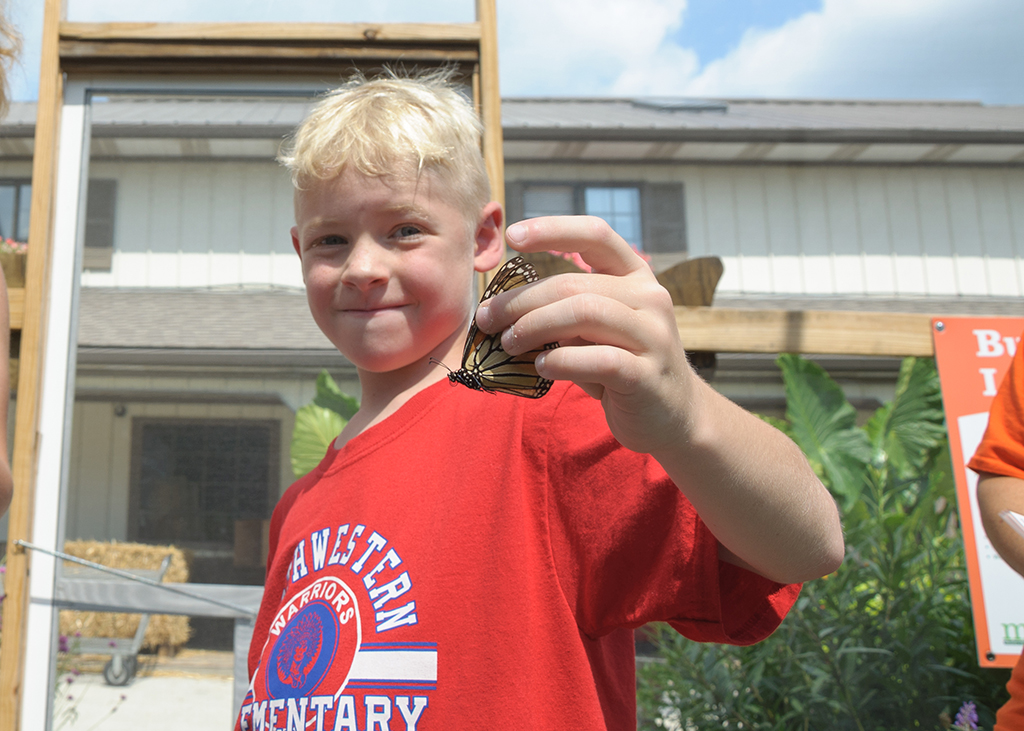Meadow View Growers’ butterfly house and weigh station gives the King of butterflies a place to call home throughout their reproduction cycle, adding positive numbers to this year’s Monarch butterfly
and pollinator population.
The Monarch butterfly also known as the milkweed butterfly and commonly mistaken as the similar Viceroy butterfly, is one of the most well known species. Their migration has served as a mystery for thousands of years, returning to the same winter roost that their ancestors called home throughout the winter months.
The Butterfly House at MVG serves as a weigh station and is home to over 100 butterfly, caterpillars and eggs that bring into being the Monarch butterfly. The chrysalis identifies the species of the butterfly before its metamorphosis, allowing the employees at MVG to provide the adequate habitat and education for growth. In order to make this a welcoming home, the staff at MVG put hours of time and care to make certain that the King of butterflies had all of the amenities to make certain of the population growth. The habitat and weigh station consists of the proper butterfly nutrition of not only the sweet smelling pollen producing flowers that serve as provisions for the emerging butterfly during their migration journey, but also milkweed plants, where the Monarch lays their eggs, a valuable nutritional resource to the newly formulated caterpillar. Milkweed, a noxious plant, although a delicacy to the Monarch, giving it its name of the Milkweed Butterfly, the toxin is stored in the butterflies body, making it toxic to other species and predators. Butterflies do not drink from large water dishes; instead, they drink from the puddles that form in the soil after a rain. MVG provides this resource by using small-granulated sand in shallow pans to allow the pooling of water that the butterflies require for hydration.
The Butterfly House at MVG is loaded with sweet smells and lavish beauty of not only the plants, but the abundance of vibrant black, orange and white of the magnificent Monarch. All of the nectar and pollinating flowering plants, trees, shrubs and ground covers in the Butterfly House carefully grown without pesticides and pest free without the presence of evasive plants and include native or plants known to the region. The Butterfly House is located in a sunny area with windbreaks to secure the vitality of the species. Not only is the MVG Butterfly House a beautiful site to witness, it also serves as an educational center for the life science of the butterfly and its life cycle to individuals of all ages.
This Saturday, September 10, MVG in conjunction with the volunteers of Monarch Watch, an organization that educates on the conservation and research of the Monarch butterfly, took part in a Monarch tagging at the weigh station located at MVG. A process explained by MVG employee, Debbie, where small sticker, placed on a certain area and completely harmless to the butterfly, serves as a label containing information such as, whether the butterfly was reared or wild, (in this case the butterflies were reared in the Butterfly House at MVG) a phone number and location for the tagging station and the sex of the butterfly. This process aids in the tracing of the butterfly during migration. A found tagged butterfly with the information contained on the label and the site of the found butterfly serves as research to help understand the migration mystery of the Monarch.
Weather patterns, such as overwintering when the cold weather moves in quicker than normal, bringing on lethal, wet, freezing temperatures. Illegal logging practices and over developing of woodland areas deplete valuable resources and bring about predators, as well as the air quality is all significant factors of the Monarch butterfly population decline in the United States and parts of Mexico. Although their brightly colored wings and markings serve as a warning to predators, showing that they are a toxic snack, does not guarantee the survival of this magnificent North American beauty.
Debbie at MVG explained that building a butterfly weigh station is an educational, fun and simple project for someone of any age and helps the environment and the pollinators of the world. Taking the Million Pollinator Garden Challenge sponsored by the National Wildlife Federation, various seed groups and conservationist form a campaign to join not only professional gardeners, and greenhouses, but also the citizens who garden for pleasure, schools and volunteers to create one million pollinating gardens by the end of 2016 (and will run for at least two years after) to reverse the alarming declining rates of pollinators nationwide. Debbie explained that a small container, patio or window garden containing plants that provide not only nutrition to the larvae (caterpillars), but also pollen a valuable nutritional source to the adult butterfly for migration and population. Butterflies, attracted to bright colors of blue, purple, yellow and white; making easy- to-grow flowers such as the Black-eyed Susan, Daisy, Lavender, Petunias and Phlox perfect for your pollinators. Planting the under grown Milkweed plant, a hearty easy-to-grow plant, serves as a valuable nesting place and nutritional resource for the caterpillar in their life-cycle transformation, as well as Aster, Citrus and Sassafras and Sunflowers for the nutrition of the Giant Black Swallowtail and the American Lady.
The staff at MVG along with the volunteers of the Monarch Watch organization plans to release the tagged Monarch species of the American Lady and the Painted Lady along with the Black Swallow species that also made the MVG Butterfly House weigh-station their home next weekend with the weather being the deciding factor. With the vast nutrition provided by the gardens at MVG the 3000-mile migration journey to the Sierra Nevada that the Monarch butterfly must travel, the various pollination gardens throughout the North American region that also provide the nutrition as well as the tag of information, the Monarch butterfly stands to prevail over the population decline.
For more information on how you can help increase the population of not only the Monarch butterfly, but also all of the various pollinators that aid in human food production, you can visit the kind staff at Meadow View Growers to assist you in the education of pollination or visit their website at www.meadowview.com. For more information on the Million Pollinator Challenge and how to register your pollinator garden and how you can help increase the Nations pollinators, please visit www.millionpollinatorgardens.org.


